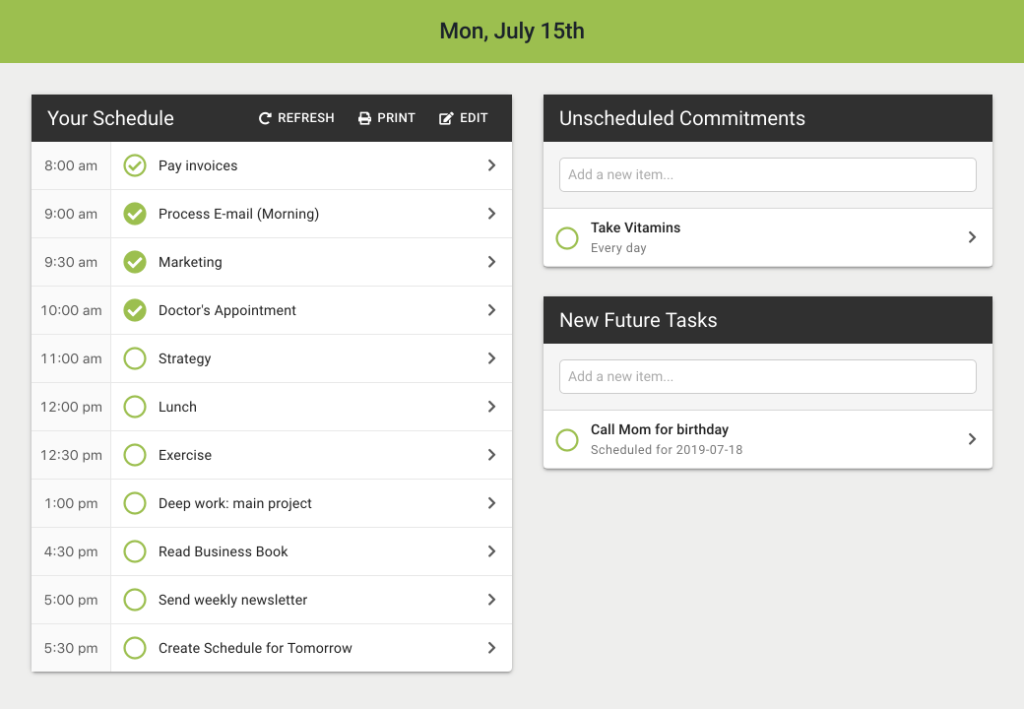I. What is a Daily Hourly Schedule?
A daily hourly schedule, a type of daily planner, is an incredibly effective tool for navigating through your day efficiently.
By utilizing the strategy of time blocking, you break down your day into defined time periods or blocks. Within each time slot, you dedicate yourself to a specific task or activity, creating an organized outline for your day.
In this format, each time block has a predetermined start time, duration, and end time. This not only provides a clear plan for what you need to be doing at any given moment, but also offers a visual representation of your day. This perspective can boost productivity and enhance your time management skills by allowing you to better understand how your time is allocated and spent.
Whether you’re aiming to achieve personal goals or professional goals, this scheduling method can transform how you approach your day.
II. Benefits of Scheduling Your Day in Hourly Increments
Choosing to schedule your day in hourly increments offers substantial benefits, particularly in combating procrastination and bolstering focus. These benefits aren’t just incidental; they’re rooted in psychological principles that inform our behaviors and influence our decision-making processes.
Time blocking is tied to the concept of “implementation intentions”.
When you schedule a task at a specific time, you’re making a commitment to yourself to begin that task when the clock strikes that time. This approach can effectively limit procrastination by introducing objectivity into your routine. It’s much harder to put off a task when you’ve scheduled it for a specific time.
In a similar vein, assigning end times to tasks introduces artificial time constraints that can enhance focus and productivity.
The realization that there’s a limited time period within which a task needs to be completed can stimulate a sense of urgency, keeping you engaged and motivated. It’s like creating mini-deadlines for yourself throughout the day.
The limited duration also creates a sense of artificial time scarcity. And when resources are scarce, your brain shifts into a focused state. By creating time blocks, you can leverage your brain’s response to this scarcity to increase your focus.
III. Creating a Schedule Using a Freeform Process
A freeform approach to creating a daily schedule offers flexibility and spontaneity.
First, start by scheduling your appointments. These fixed commitments form the basic structure of your schedule.
Next, assign daily activities like eating lunch and exercising and daily tasks from your task list to time slots, allocating blocks of time for each task or activity.
Finally, remember that life can be unpredictable, so it’s crucial to leave some space in your schedule for breaks, unexpected interruptions, and additional tasks that might pop up. Regular breaks are especially important for proper time management to maintain peak productivity and avoid burnout.
Once your done, you’ll have a complete schedule that you can use to guide your day.
Pros & Cons of a Freeform Process
Freeform scheduling offers flexibility, spontaneity, and a certain degree of freedom. This method suits those who know what their priority tasks are, have a good sense of how long tasks take and are comfortable making on-the-spot decisions.
Pros:
- Provides Flexibility
Freeform scheduling allows you to assign tasks to time blocks as you please. You can easily adjust your schedule to accommodate new tasks, last-minute changes, or sudden shifts in priorities. - Allows for Spontaneity
With this approach you can jump straight into scheduling your day without spending time deciding what you should be doing or how long things will take.
Cons:
- Easily Succumbs to Biases
It’s easy to subconsciously underestimate the time required for tasks so you can fit more into your day—but this just results in an unrealistic schedule that may demotivate you when you fall short of finishing it. - Requires Task-Time Awareness
You need to have a solid understanding of how long your tasks take. Misestimating task durations can lead to overruns and uncompleted tasks. - Nudges Toward the Wrong Defaults
After you’ve filled out your schedule, you may find that you’ve missed a couple of crucial tasks. Since you haven’t yet even committed to doing these tasks today and you’re schedule is already full, it’s easier to convince yourself to skip them, even if these are your biggest tasks for today.
Overall, while easier to create, freeform schedules tend to be less optimal than those created using a structured process.
IV. Creating a Schedule Using a Structured Process
There are several methods of creating a daily hourly schedule, but I recommend the CASE method. The CASE method offers a systematic and structured approach to creating a daily schedule in 4 steps:
- Commit
Decide what tasks, appointments, and activities you want to accomplish today. Make sure they related to your professional life or personal life goals. - Allocate
Assign a specific duration of time to each task. This involves estimating how long each task will take—or, if it will take multiple days to complete, how long you want to work on it today. - Schedule
Put each commitment into a specific time slot. This step helps organize your tasks into a structured, sequential format that you can use to keep track of where you are against your plan throughout your day. - Evaluate
Review the schedule you created for potential conflicts or issues and make necessary adjustments to ensure it’s achievable.
While the CASE process provides a structured way to plan, it also requires a certain level of discipline and might be less flexible than the freeform approach. However, it can be a fantastic way to ensure that no task is forgotten and each has a designated time slot, promoting balance between your current tasks and any urgent tasks that may arise.
Pros & Cons of a Structured Process
Process-driven scheduling, like the CASE method, offers a systematic and structured approach to creating a daily schedule.
The CASE method is beneficial for individuals who have a tendency to create unrealistic schedules when using a freeform process, who want to optimize how their brains think during the planning process or who simple prefer more structure in creating a daily hourly schedule.
Pros:
- Creates Realistic Schedules
By taking the time to determine your daily commitments and allocate time to them before you look at your hourly schedule, you can avoid the tendency to underestimate commitments to fit more on your schedule and have a better chance of creating a more realistic schedule - Focuses on Tradeoffs
Most days, not everything you want to do in your day you’ll have time for. Using a structured process gives you the ability to make better tradeoff decisions on what is most important to include on your schedule and when to include it.
Cons:
- Requires a Learning Curve
The systematic approach takes time to learn how to implement the system correctly, and early setbacks when learning a structured process can make some people abandon the process altogether. - Requires Discipline
To fully leverage the benefits of a process-driven schedule, you need discipline to build your schedule using the process every day.
Overall, while a structured process takes time to learn, they tend to create more optimal schedules than those created using a freeform process.
V. Paper vs Digital: Which is Better?
The decision between paper-based and digital daily planners is highly personal, as both methods have their pros and cons.
Paper-based hourly planners offer a tangible and satisfying record of your plans and achievements. They can be easier to grasp for some people who prefer a visual and physical connection with their plans. However, it can be less adaptable to changes and isn’t as portable or accessible as a digital planner.
Conversely, digital daily planners are highly flexible and accessible from virtually anywhere. Digital daily planners include both digital daily planner templates and daily planner apps like Day Optimizer.
Often they allow for quick adjustments, reminders, and even sharing of schedules—and it’s easier to follow a structured planning process if you’re being guided through it by an app. However, it can sometimes offer more opportunities for distraction, and those less comfortable with technology might find it a little daunting.
The best method for you depends on your personal preferences, comfort with technology, and specific needs.
VI. Summary
In summary, a daily hourly planner, whether a printable template, a digital daily schedule template, or a digital day planner like Day Optimizer, serves as a significant tool for effective time management.
Whether you prefer the flexibility of the freeform approach or the structure of the CASE process, it’s crucial to ensure your schedule is flexible and adaptable and that you create one on a daily basis.
Both paper and digital formats have their unique strengths and weaknesses, and the ideal choice depends on your individual preferences and needs. The key is to select a method that enhances your productivity and supports you in achieving your daily goals.
Remember, the aim is not to craft a perfect schedule but to design an effective one that aids in efficient task management and helps you achieve your goals on a daily and weekly basis.








